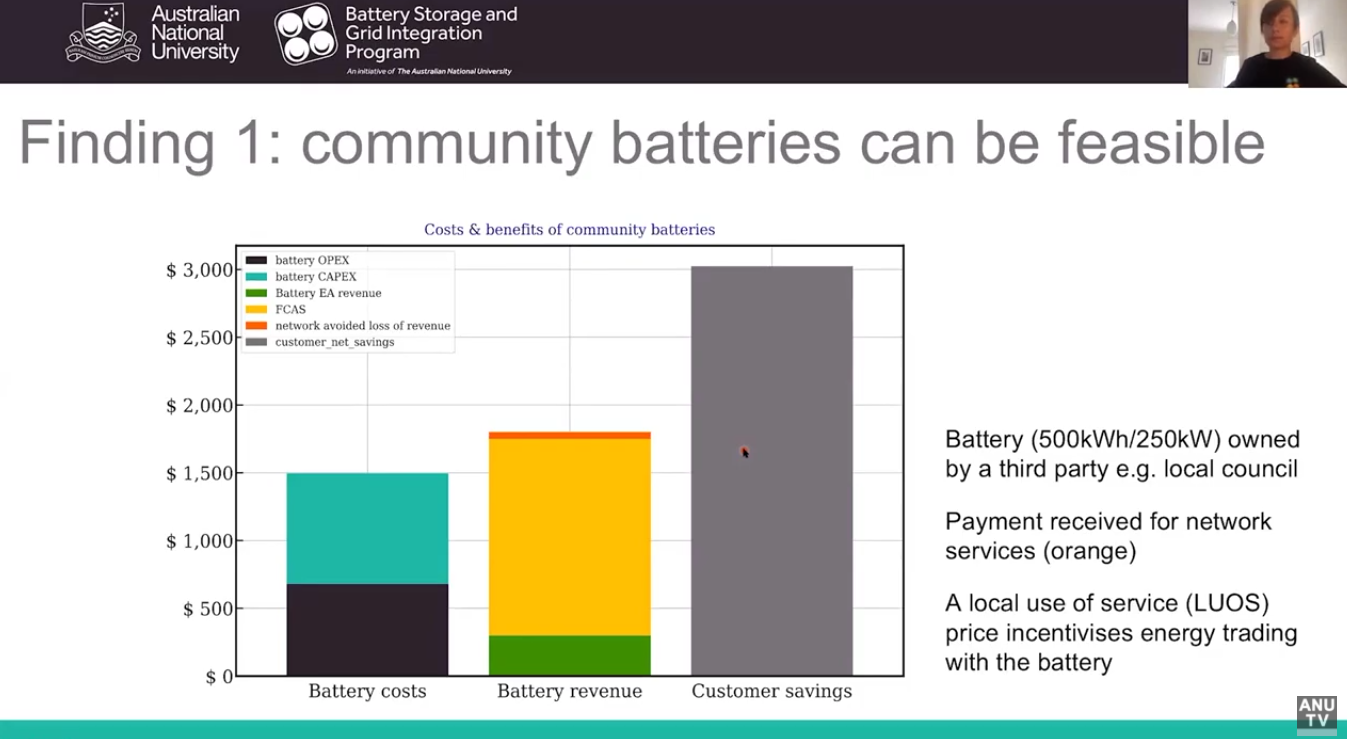
There is a middle ground between home and utility-scale batteries: the community battery. New research shows community batteries bring more benefit than individually owned energy storage systems.
The ACT government reckons there’s a gap between the household battery and grid-scale batteries: community batteries, either owned by or at least serving the needs of collectives of households.
In the case of the ACT, the new 700-home development of Jacka is designed to have solar panels on every house, so the government and Evoenergy are partnering with the Australian National University to see whether a community battery would suit the development.
In a streamed seminar last week, the Australian National University’s Energy Conversations heard from researchers Dr Marnie Shaw (of the ANU Battery Storage and Grid Integration program), and sociologist Dr Hedda Ransan-Cooper (research fellow in the Battery Storage and Grid Integration program), who discussed the challenges facing community batteries in terms of market and community acceptance.
Community batteries (in scale, ten to 100 times the size of the typical household battery) are being trialled in Western Australia – with a Tesla unit currently trialling in the Perth suburb of Ellenbrook and another heading for Kalgoorlie-Boulder among them. In the eastern states, NEM regulation is the hurdle: Dr Shaw explained while it’s logical for a generator to own and operate the battery, those organisations aren’t allowed to trade directly with consumers.
So Dr Shaw’s work focuses on what (if anything) needs to change to enable community batteries on the east coast, and as part of that, her team modelled the viability of a 500kWh battery in the Jacka community.
Her team’s two key findings are that a community battery would generate customer savings double the cost of the battery; and that it would support more solar power installed on houses in the development.

The money shot: Dr Marnie Shaw’s research shows community batteries are financially viable
As we know, household solar electricity exports are becoming a headache for grid operators. The industry has recently proposed technical guidelines for freeing data from behind the meter so that exports are more manageable, and last year we heard SA Power was experimenting with dynamic export limits to try to avoid zero-rating households with solar power systems.
Dr Shaw told the seminar home solar batteries are already helping solve grid issues, by reducing exports by around 25%, but community batteries reduce exports by around 50%.
The ACT Suburban Land Agency’s Rob Thorman emphasised the importance of managing exports: Jacka’s 700 homes will, if unmanaged, certainly push enough electricity into the grid to cause disruption.
Solving The “People Problem”
So, while the community battery is technically and financially feasible, it would need an answer to the regulatory question – who best to own the battery?
That’s where Dr Ransan-Cooper’s work as a sociologist comes in. There are plenty of alternatives to the grid operator owning the community battery (the state government, the local council, or the community, for example) – the question is which model is most likely to be attractive to the community the battery serves.
In her surveys and focus group work, Dr Ransan-Cooper said energy professionals are clear that community batteries offer a:
“huge range of benefits”, including “stabilising the grid, avoiding grid upgrades, and building trust in the NEM”.
It’s at the community level that the concept has to be “sold”, because it’s an unfamiliar concept to the ordinary householder.
“To be successful, community storage would have to either fit with the existing electricity system or if it can’t, it’s got to stretch or transform it in some way,” Dr Ransan-Cooper told the seminar.
Dr Ransan-Cooper said one of the most important aspects of the community battery is that it helps overcome one of the thorniest renewable energy issues – equity. Too many households are excluded from the household renewables revolution, either because they can’t afford household PV, or because they’re renters or apartment owners. Being able to take electricity from a community battery lets those groups participate in the world of residential renewables.
“Local storage could fit with pretty minimal to no regulatory changes – but community concerns about the nature of the electricity systems mean there is the possibility for this to be more disruptive,” she said.
The ANU team’s research with householders found people are more comfortable the closer to “home” the battery is owned because they like the idea of taking back more local control of the governance of their energy system (rather like the by-now-ancient model, in which local government built and owned electricity generation).
Dr Ransan-Cooper said having the batteries owned and operated at close to the local level recognises that electricity is:
“a social good, not necessarily just an individual good”.
And community-level ownership of the battery keeps money closer to the community, she added.
Author’s note: Engineers and tech people are apt to dismiss the social sciences, so it’s gratifying to see the ANU getting sociological research in such an important project – RC

 RSS - Posts
RSS - Posts



This community battery idea is by far the best system I have heard of so far.
This column has researched and proved the fact that home batteries are uneconomic while giving owners that fuzzy feeling, and are likely to be so or marginal for years to come.
The community battery offers those that cannot afford them the benefit without the expense and saves their unused grid feed-in going to waste when it is unable to be used in the grid and postpones costly network upgrades and negates the need of recently discussed on here the need to switch off feed in at the inverter in certain circumstances.
This Canberra idea could be expanded to include other existing communities as rooftop solar increases offering further network upgrade savings.
The only problem is our privatized system that will see it as a profit dampener.
.
Battery costs are going to fall like a stone over the next ten years in a similar trajectory to what we have seen in the solar industry.
In ten years a 25 kWh battery will be the same size as today’s powerwall with a twenty year warranty and cost around $3000.00
In ten years many consumers will be able to affordably provide 95% of their own energy needs including charging their own electric car.
The question then becomes what is the role for the grid and who should own it?
I think the grid will have to be nationalized because it will become economically unviable.
Great research, this is the way we need to go.
Batteries will be more efficient, cost effective and environmentally friendly if they are run as a shared resource and managed by technically capable operators.
Battery installations need on-going monitoring and management to work effectively and meet their warranted lifespan.
Many individual home battery systems have failed due to inappropriate selection/design, unintentional misuse/neglect by the householders, or the property changing hands.
I think “suburb” batteries are great way to meet the human aspect of electricity needs. Having people understand that “this is the battery for your suburb” is useful and puts a tangible reality around it.
In the end, it doesnt make a lot of sense for people in houses to have to understand the intricate details of electrical storage/chemistry/connection issues/long term remediation/maintenance schedule etc. That’s why we have experts.
I think we’re really just in the “early adoption” phase of battery technology, where as a society we’re trying to figure it out at a broader level.
The long view might be to have the battery absorbed into the part of the network that looks after the poles’n’wires. General ‘connection to the grid’ cost goes up $x but usage charges go down $y.
The current approach regarding measured consumption/exporting could stay the same, because the number of panels & individual usage per home is precisely that – a per home thing.
The concept of community batteries is so obvious that it should be given a huge priority by the Fed Govt. It would create countless jobs, enable stretching of the grid and also give cheaper power to those who need ti the most.
It is such an easy concept to get off the ground – the network operators already know which suburbs have hig concentrations of Solar and give them power with grid overload, why not develop a containerised system – deployable in modules of 20ft shipping containers – that could be dropped in and connected wherever required – in my suburb alone – there are 4 of the large green transformers that take the high voltage grid input and drop it down to the standard voltages we expect – why not co-locate a shipping container with each of these and add 1 megawatt or so of storage – minimal cost – push back or negate the need for grid upgrades and help stabilise the grid voltage.
I have been quoted $35K for a commercial 3 phase battery storage system that can dump 30kw sustained to and from the grid – this is fully installed with 40KWh of battery – put 12 of these in a container and you have 500kwh of storage for less than $500K at retail prices.